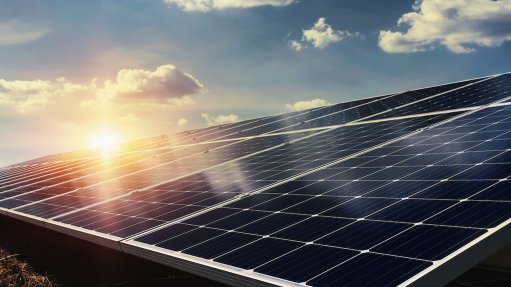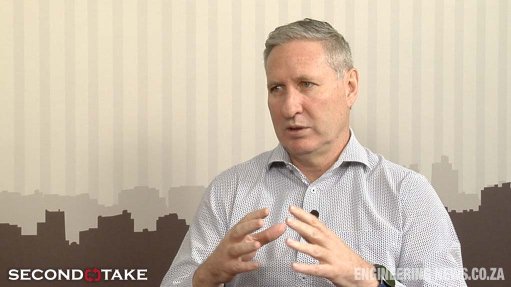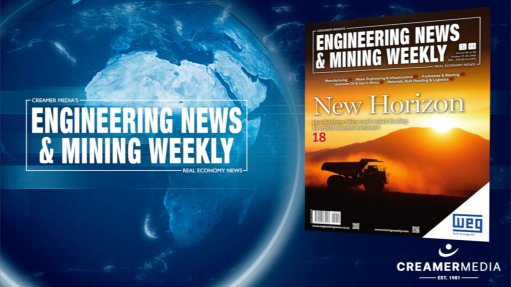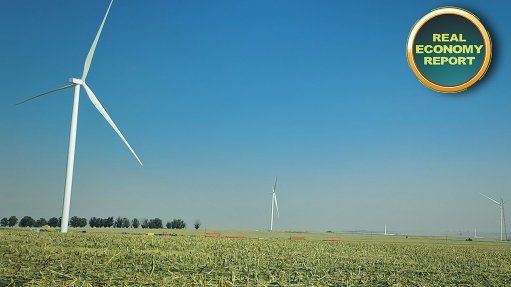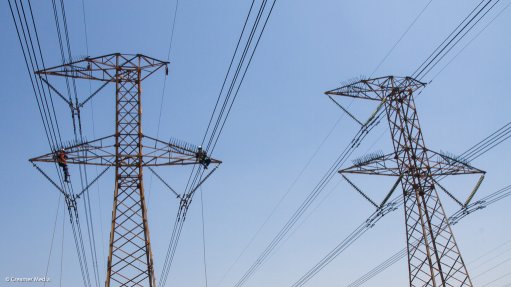Long-term demand outlook for platinum is robust, ongoing question mark over supply

World Platinum Director of Research Edward Sterck interviewed by Mining Weekly's Martin Creamer. Video: Darlene Creamer.
JOHANNESBURG (miningweekly.com) – The long-term outlook for platinum from a demand perspective is pretty robust. The question, once again, is whether supply will be adequate to meet it.
“In terms of automotive demand, we can't overlook that the drive train is going to continue to electrify. It's just the pace of that electrification that is quite difficult to predict as things stand at the moment,” World Platinum Investment Council (WPIC) research director Edward Sterck commented to Mining Weekly in a Zoom interview. (Also watch attached Creamer Media video.)
Given platinum's far-reaching application diversity, Sterck was responding to a question on WPIC’s long-term demand forecast, following its publication on Tuesday of the 'Platinum Quarterly' for the third quarter of 2024, which pronounced the third consecutive platinum market deficit of 539 000 oz for 2025.
Automotive demand continues to feature as a demand growth driver for 2025, with the slowdown in battery electric vehicle (BEV) demand leading to a sustained automotive platinum need over a longer period, bolstered by stricter emissions legislation, more hybrid vehicles that contain platinum-catalysed internal combustion engines (ICEs), as well as the additional use of platinum to substitute palladium
Interestingly, automotive demand is projected to hit an eight-year high of 3 245 000 oz next year amid above ground platinum stocks being poised to fall in 2025 to 3 014 000 oz.
“As things stand at the moment, we've seen that ongoing consumer reluctance to adopt full battery electrification is resulting in a slower rate of the growth in BEV market share, so higher-for-longer ICE,” Sterck pointed out.
Overall, however, a negative compound annual growth rate (CAGR) of around 1.2% in total platinum group metals demand for automotive applications is expected.
For jewellery, the long-term outlook is broadly flat, but with some signs of upside potential beginning to show.
While significant subsectors of industrial demand go up and down, industrial demand has over the last 11 years been at a consistent 3.5% CAGR, which is expected to continue.
Meanwhile, in the 2030s, hydrogen is likely to become the biggest sector of all of the others and more than offset the decline in automotive demand.
On the long-term investment demand front, continued growth of demand for the physical bar and coin is likely, with exchange traded fund, or ETF, demand expected to begin to reflect the ongoing deficits.
“But at some point, given we've got ongoing shortages of platinum for the foreseeable future, ETFs may become a source of supply, albeit at much higher prices than we see today.”
SUPPLY DEFICIT
The supply deficit theme is becoming embedded by ongoing mine supply constraints, with a slight 2025 recycling recovery forecast owing to improved availability of end-of-life autocatalytic converters.
The market is expected to reach a deficit of 682 000 oz in 2024, as the exceptionally strong demand from the previous year is sustained, reaching 7 951 000 oz (flat year-on-year) and again exceeding supply, which remains constrained at 7 269 000 oz – a 2% increase year-on-year.
Mining Weekly: Despite some improvements in recycling, platinum supply remains severely constrained. What are the specific challenges facing platinum mining and recycling and how are these likely to be resolved?
Sterck: In terms of mining, it's really a function of the restructuring activities that the miners have taken in response to the fall in the prices of palladium and rhodium, so we've seen around 10 000 jobs exit the industry through this restructuring process. Some shafts have been placed on care and maintenance, with quite big announcements coming out of North America, for example. In effect, the miners are trying to improve the economics of the mines and prioritising focusing on costs rather than outputs. In terms of recycling, it's just this ongoing shortage of end-of-life vehicles. Yes, we do have a small recovery expected for next year, but we're remaining well below historical recycling rates, and I would say that there's possibly some risks to the outlook of that recovery for next year. If you talk to the recyclers, they're all expecting material to come through at some point in the future, but it's just taking longer to materialise, and the recyclers aren't necessarily seeing it flow through in the way that one might expect.
Automotive platinum demand is projected to reach an eight-year high in 2025. What factors are contributing to this surge, especially in the context of increasing electric vehicle adoption, and how significant is platinum substitution for palladium in this scenario?
For 2024, we've got about 750 000 oz of substitution in our numbers. Looking to next year, we haven't disclosed the substitution number as yet, but it is higher than that. The main drivers are ongoing hybridisation of the drive train, so the residual ICE vehicles are more likely to be hybrid vehicles, which typically have 10% to 15% higher loadings than a conventional ICE vehicle. We've gotten a bit of an increase in terms of heavy-duty demand for next year as well, which is obviously diesel, so quite a significant demand pull. In terms of the absolute numbers, we’re continuing to see electrification of the drive train. If we look at 2024, the forecasts from global data, which feed into our numbers, were that the expectations for BEVs were continually being downgraded. They've got 36% year-on-year growth in BEVs projected for 2025. There are some risks to that outlook but that's what's in our numbers. We do have about a one-million-unit lower outlook for light duty ICE vehicles, whether hybrid or pure ICE, for 2025, so, really, the platinum demand is being driven by that hybridisation, by the increase in heavy duty vehicle demand, and then also by substitution.
The jewellery sector is showing steady growth, particularly with a surge in Indian fabrication. What are the drivers behind the increased demand in India, and how do you see global consumer preferences influencing platinum jewellery demand in other key markets?
In India, you've got a couple of different factors at play. Firstly, there's fabrication for export, so India has been producing quite a lot of platinum jewellery for export to the Middle East, the UK and the US. But in terms of the domestic market, we're just seeing growing interest there, and it's been driven by a couple of factors, one of which is the elevated price of gold, which is more of a global theme, but it's causing some consumers to look for alternative metals at a lower price point, and that would include platinum. But one of the big success stories in India has been that Platinum Guild International, our sister organisation that promotes platinum jewellery, has been sponsoring Indian cricketers to wear platinum jewellery. As we all know, cricket is quite a popular sport in India, and that seems to be getting a lot of attention. A lot of this is male jewellery, and it’s just helping to drive that significant year-on-year increase in that geography.
In terms of the broader market, and particularly when we're thinking about the bridal sector, which is quite an important area for platinum, white gold has been a major competitor for platinum in the bridal jewellery market for quite a long time. We're now seeing price parity between platinum rings and white gold rings. In effect, for the consumer, if there's no financial difference between white gold and platinum, I would argue people are more likely to choose platinum, so that's quite an emergent trend in the jewellery space at present. The significant increase in the gold price over the last 12 months or so has had a big impact on the working capital requirements of fabricators and jewellers, and if they can rotate some of their gold stock into alternative metals, including platinum, then obviously that helps liberate working capital and makes that capital available for other activities. Those are the main things that are driving the platinum jewellery market at the moment and a 2% year-on-year demand increase is the forecast for 2025. It’s not a major increase, but after many years of platinum jewellery market decline, it's possible that we are seeing a bit of a bottom here, and we could be looking at modest growth going forwards.
Industrial demand for platinum is expected to decline by 9% in 2025 as capacity expansions taper off. What are the reasons behind this projected decline and which industrial sectors are most impacted?
For most industrial activities, it's not necessarily platinum consumption that drives the demand outlook, but it's more the timing of capacity additions. This is where new plants are being commissioned in, say, the petroleum or chemicals or glass sectors. That's where platinum is not actually being consumed in the industrial process, but it's being used either as a catalyst to accelerate chemical reactions, or, in the case of the glass industry, it's being used as a lining for the furnaces where they melt this glass, and for the bushings through which they draw the glass fibre. A lot of demand depends purely on the timing of when new projects are being constructed. It just happens that next year, far fewer glass facilities are expected to be commissioned and so that's really what's driving the 9% year-on-year decline in industrial demand. Other areas are growing quite significantly within industrial. Hydrogen, with other fuel cell applications, is growing 38% year-on-year, admittedly off a small base, but effectively the overall picture is slightly muddied by the glass subsector.
Investment demand remains net positive, bolstered by Chinese bar demand. There were also new retail initiatives like Costco selling platinum in the US. How significant are these trends and what is the likely impact of them in the mid to longer term?
We're seeing ongoing growth in the investment market in China, which is a relatively new market for platinum investment. It's gone from pretty much zero in 2018 to a projection of well over 200 000 oz for this year, continuing to grow into next year. To a degree, there's an element of market development, which is largely what we've been working on with our colleagues in China. But it is partially also gold-related. Investors are looking for alternatives to gold as a safe haven. There's a lot more product available in China now. China Gold Coin, for example, has just launched its one kilogram platinum bar, and we've got quite a few different platinum bar products on the market now, including things going down to only a gram in size, so much more accessible to less affluent or younger investors.
In terms of Costco, that's been a fascinating story to watch. The amount of press interest in it has been stratospheric. Costco is the third biggest retailer globally and in the US, it's a very well regarded brand. Because they're very selective about what they stock, if Costco is stocking something, then it must be good, and so that has translated into this really significant media interest. It broadens the awareness of platinum as an investment amongst consumers. Because the news around Costco is so new, it's not really baked into our forecasts, but what we are seeing is spillover interest, where consumers are going to our other vendors of platinum and buying platinum from them instead, or from Costco, largely as a result of the growing awareness around platinum as an investment product, so it's been extremely helpful from that perspective, and quite a fascinating process to watch.
Green hydrogen development is highlighted as a growing segment for platinum demand. How is platinum's role in the hydrogen economy influencing its demand outlook, and what potential does this sector hold for the future of the platinum market?
Platinum has a couple of different roles within the hydrogen industry. Firstly, it's used as a catalyst in the electrolysers for producing green hydrogen through the electrolysis of water, powered by a renewable power source. It's also used in the fuel cells that can take that hydrogen as an energy carrier, recombine it with atmospheric oxygen, and that generates electricity. The only byproduct from that is water, so it fits in at both ends of the hydrogen value chain. The outlook, I think, is one that is quite attractive. There's been quite a lot of negative headlines around hydrogen recently. Effectively, things have been going more slowly than people had initially expected. What we are seeing now is that the subsidies available from various governments around the world are beginning to be deployed, and that is translating into projects going through final investment decision, or FID, and construction is starting on these mega electrolyser projects around the world. I think the key thing for hydrogen is that the infrastructure needs to be in place in order to drive the demand and that infrastructure is what's taking longer to come through than expected.
The fuel cell manufacturing capacity has been running well ahead of the demand for fuel cells, because consumers haven't had confidence that the hydrogen will be available. But we're seeing that begin to solve itself now. In terms of stationary applications, we're expecting 38% year-on-year growth for 2025 that is admittedly off a fairly low base, but it is beginning to become relatively more meaningful in terms of absolute numbers of ounces that are feeding into that. But longer term, by the time we get out towards 2030, we're expecting demand to grow to around 850 000 oz a year, so really beginning to become quite meaningful, and heading into the 2030s later in the decade, we expect hydrogen to be the biggest driver of platinum demand of any of the sectors.
PLATINUM’S RESILIENCE
At a time when the global economy is uncertain, one might expect an industrial metal like platinum to perform poorly. However, WPIC reports, platinum demonstrates resilience owing to its diverse end-uses, even in the current environment.
At the centre of the issue, supply remains constrained for mined and recycled platinum.
In quarter three, above ground stock releases have masked mining’s decline. But ongoing headwinds present downside risks to supply into next year, especially as miners reassess production plans and restructure operations to manage the negative impact of the platinum group metals’ basket price on mining sustainability.
“It's worth noting that supply rationalisation plans will have a short-term negative effect while also severely constraining any near-term supply response to demand growth or higher platinum prices,” WPIC CEO Trevor Raymond commented.
“In terms of platinum investment, we’re delighted that Costco is making platinum even more accessible for investors in the US – it is now selling platinum bars and coins. This has significantly increased awareness of platinum as an investment asset that can be included in retirement portfolio planning.
“Green hydrogen development and deployment remains firmly on the agenda, as various initiatives at the recent COP29 highlighted. The relevance of platinum's role in the hydrogen economy remains as strong as ever. This is steadily capturing the attention of global investors, offering a compelling opportunity to engage with assets connected to global decarbonisation efforts,” Raymond added.
While platinum demand from autocatalysts has equated to between 30% and 44% of total demand in the last five years, the metal’s diverse non-automotive industrial uses account on average for 32% of total global five-year-average demand.
Over the same period, global annual jewellery demand has averaged 26% of total platinum demand, with investment demand the most variable category at between -10% and 20% of total demand, excluding movements in unpublished vaulted investor holdings.
Article Enquiry
Email Article
Save Article
To advertise email advertising@creamermedia.co.za or click here
Comments
Press Office
Announcements
What's On
Subscribe to improve your user experience...
Option 1 (equivalent of R125 a month):
Receive a weekly copy of Creamer Media's Engineering News & Mining Weekly magazine
(print copy for those in South Africa and e-magazine for those outside of South Africa)
Receive daily email newsletters
Access to full search results
Access archive of magazine back copies
Access to Projects in Progress
Access to ONE Research Report of your choice in PDF format
Option 2 (equivalent of R375 a month):
All benefits from Option 1
PLUS
Access to Creamer Media's Research Channel Africa for ALL Research Reports, in PDF format, on various industrial and mining sectors
including Electricity; Water; Energy Transition; Hydrogen; Roads, Rail and Ports; Coal; Gold; Platinum; Battery Metals; etc.
Already a subscriber?
Forgotten your password?
Receive weekly copy of Creamer Media's Engineering News & Mining Weekly magazine (print copy for those in South Africa and e-magazine for those outside of South Africa)
➕
Recieve daily email newsletters
➕
Access to full search results
➕
Access archive of magazine back copies
➕
Access to Projects in Progress
➕
Access to ONE Research Report of your choice in PDF format
RESEARCH CHANNEL AFRICA
R4500 (equivalent of R375 a month)
SUBSCRIBEAll benefits from Option 1
➕
Access to Creamer Media's Research Channel Africa for ALL Research Reports on various industrial and mining sectors, in PDF format, including on:
Electricity
➕
Water
➕
Energy Transition
➕
Hydrogen
➕
Roads, Rail and Ports
➕
Coal
➕
Gold
➕
Platinum
➕
Battery Metals
➕
etc.
Receive all benefits from Option 1 or Option 2 delivered to numerous people at your company
➕
Multiple User names and Passwords for simultaneous log-ins
➕
Intranet integration access to all in your organisation








